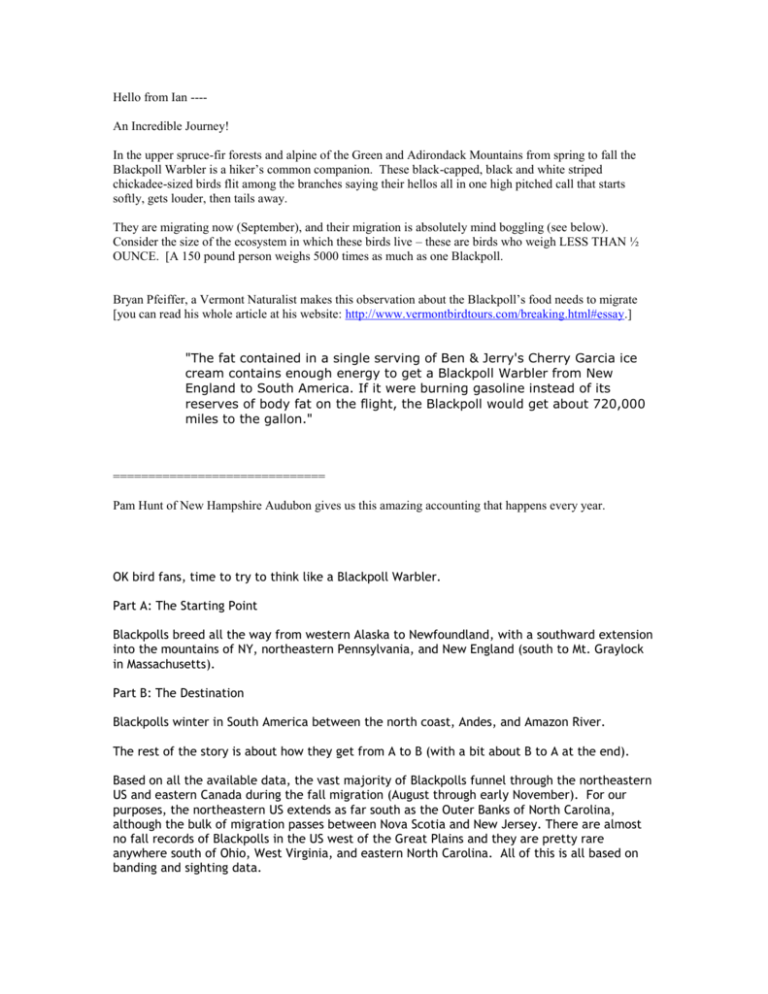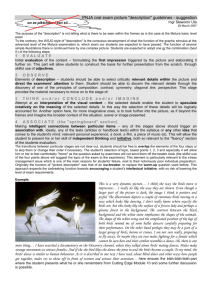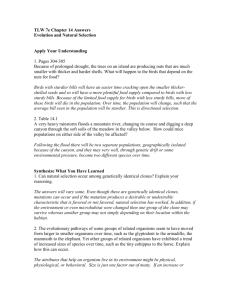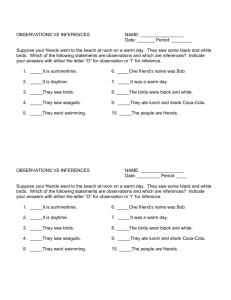An Incredible Journey (Word file)
advertisement

Hello from Ian ---An Incredible Journey! In the upper spruce-fir forests and alpine of the Green and Adirondack Mountains from spring to fall the Blackpoll Warbler is a hiker’s common companion. These black-capped, black and white striped chickadee-sized birds flit among the branches saying their hellos all in one high pitched call that starts softly, gets louder, then tails away. They are migrating now (September), and their migration is absolutely mind boggling (see below). Consider the size of the ecosystem in which these birds live – these are birds who weigh LESS THAN ½ OUNCE. [A 150 pound person weighs 5000 times as much as one Blackpoll. Bryan Pfeiffer, a Vermont Naturalist makes this observation about the Blackpoll’s food needs to migrate [you can read his whole article at his website: http://www.vermontbirdtours.com/breaking.html#essay.] "The fat contained in a single serving of Ben & Jerry's Cherry Garcia ice cream contains enough energy to get a Blackpoll Warbler from New England to South America. If it were burning gasoline instead of its reserves of body fat on the flight, the Blackpoll would get about 720,000 miles to the gallon." ============================== Pam Hunt of New Hampshire Audubon gives us this amazing accounting that happens every year. OK bird fans, time to try to think like a Blackpoll Warbler. Part A: The Starting Point Blackpolls breed all the way from western Alaska to Newfoundland, with a southward extension into the mountains of NY, northeastern Pennsylvania, and New England (south to Mt. Graylock in Massachusetts). Part B: The Destination Blackpolls winter in South America between the north coast, Andes, and Amazon River. The rest of the story is about how they get from A to B (with a bit about B to A at the end). Based on all the available data, the vast majority of Blackpolls funnel through the northeastern US and eastern Canada during the fall migration (August through early November). For our purposes, the northeastern US extends as far south as the Outer Banks of North Carolina, although the bulk of migration passes between Nova Scotia and New Jersey. There are almost no fall records of Blackpolls in the US west of the Great Plains and they are pretty rare anywhere south of Ohio, West Virginia, and eastern North Carolina. All of this is all based on banding and sighting data. In other words, birds from as far away as Alaska have already traveled across the entire continent to reach the Northeast, a distance of roughly 3000 miles. When they pile up along the northeast coast, they may spend a couple of weeks eating, gaining weight, and waiting for the appropriate weather conditions. And they put on quite a bit of weight, going from a lean mass of 11-12 grams to as high as 20-23 grams (or from roughly half-an-ounce to an ounce). The prevailing winds in the Northeast are from the northwest, and birds may wait for a particularly strong NW flow to start them on their journey. However, given the distance they are about to travel, a short-lived cold front is not as critical as it might appear. The birds take off in the evening heading southeast, and essentially fly straight out over the North Atlantic Ocean. Mass take-offs to the southeast detected by radar cannot be identified to species, but one assumes that many of these birds are Blackpolls (and for the record, there is some discussion of whether Connecticut Warblers follow a similar strategy). The birds maintain a SW bearing until they approach the Tropic of Cancer, at which point the prevailing winds shift to northeast (the Trade Winds). At this point the birds are deflected south and southwest toward the South American mainland. Depending on where they left North America, this distance is between 1500 and 2000+ miles. It can take up to 88 hours (yes, that's threeand-a-half days). How do we know they take this overwater route? For one thing, Blackpolls are rare in Southeast in the fall, as already stated. For another, they are a regular fall migrant on Bermuda (triangle not withstanding), which lies smack dab in the middle of the over water route. Finally, they have been recorded in sometimes impressive numbers on boats far out to sea (sometimes even accompanying shorebirds, although the latter are obviously moving faster). Blackpolls are also quite rare in the Caribbean west of Hispaniola. They are pretty common on Puerto Rico, the Virgin Islands, and the Lesser Antilles, which again lie right in the proposed migration route. When I was doing waterthrush research in Puerto Rico in October, we'd catch a few Blackpolls. Many were actually below the normal lean weight, suggesting they had started to metabolize muscle toward the end of the overwater trip. Once they've hit landfall in the eastern Caribbean or northern South America, they can feed and fatten up enough to complete whatever legs of the migration remain. Some may still travel 1000 miles or more southward into Amazonia or beyond. While most people buy into this scenario, there is one very vocal critic of the overwater hypothesis, who instead proposes a land route via Florida and the Greater Antilles. A lot of the debate (such as it is) revolves around the merits of relative abundance data and weight data. Obviously, I come down on the side of the plan I've outlined, largely because of the species' a) rarity in Florida (except after storms), b) abundance in Bermuda, and c) low weights in the Caribbean. To summarize, the farthest a Blackpoll might travel IN THE FALL (we'll get to spring in a second) is some 6000-6500 miles between western Alaska and northern Bolivia. The shortest would be perhaps 1500-2000 from New England to northern Venezuela. Recapture and colorbanding data (some from right here in NH on Mt. Cardigan by yours truly) suggest an average lifespan of 3-5 years. That's a lot of miles, not even counting the return trip. In spring (April to May), Blackpolls appear to cross the western Caribbean directly from Columbia and Venezuela to Cuba, and thence to Florida and the Gulf Coast as far west as Louisiana. There are a few records from Jamaica, but essentially none from Central America, so it appears an overland route is out this time as well. From the southern US, they fan out to the north, spreading as far west as the front range of the Rocky Mountains, and obviously northeast to the Canadian Maritimes and New England. In general, this spring route is more direct for western populations, but perhaps a little longer for the northeastern ones. You can't blame them though - who'd want to travel 2000 miles over water into a headwind! Add it all together and the average Blackpoll Warbler (let's say it lives to be 4 years old = four round trips) travels between 14,000 (New England/Venezuela) and 50,000 (Alaska/Bolivia) miles in its lifetime. For any population, roughly 8000 of these miles are overwater. For a bird this size, the whole thing is pretty mind-boggling. Shorebirds and seabirds are the only groups that make long journeys with such an extensive overwater leg. But shorebirds are significantly larger and fly much faster, while seabirds can stop and eat whenever they want. Remember, this is a half-ounce insectivorous bird flying NON-STOP for over three days. Maybe it's lucky, and can take a break in Bermuda, but most don't have that option unless they intend to become fish food. People often try to visualize this feat in human terms. On the radio Monday, Mark made the comment about how many pizzas we'd have to consume to gain weight at the rate a sandpiper does. But such comparisons will always be flawed, since humans are physiologically so radically different from migratory birds. Rather than trying for the caloric equivalents, simply visualize the monumental task of doubling your weight in two weeks, and THEN exerting yourself (a fast walk, perhaps) for three days without eating. I suspect that we'd be barely able to move after the initial episode of gluttony, much less carry out sustained activity of any sort. So keep that in mind when you next see a Blackpoll Warbler. By the end of the month it will have launched itself over the North Atlantic, perhaps for the first time in its life, and there's a 50/50 chance it'll be back to do the exact same thing next fall. Humbling. Pam =============== And for the poets among you, another version of this story: The Journey by Pamela Denise Hunt (Fall 1999 - February 2001) It is autumn in the northlands Nights get longer, leaves turn yellow Their breeding season over Restless songbirds start to move From Alaska, Canada, New England they come Half-ounce feathered mites of green and yellow Leaving vast forests of spruce and fir On a journey most have never made To the south and east an ocean awaits them Long as a planet and a fifth as wide A place without forests, and even food Where wind and wave shape a watery world They stop to feed, these tiny travelers Flitting through coastal thickets and woodlots Converting insects, even berries Into a body's worth of fuel A northwest wind provides the signal Darkness falls, the flocks take wing Guided by stars and hidden senses They set off across the open sea Three days they fly, maybe more And some are lost to the waves below No land in sight, no place to rest Driven by the call of an ancestral home The tradewinds shift, and south they turn And land exhausted on a distant shore A new continent, vast and green Where a great river winds through a dwindling forest Here they spend the winter months As visitors in a foreign land Feeding, roaming through the forest And waiting for the season's turn In lengthening days they prepare to return Changing winter colors to those of spring Gone are the greens and yellows of autumn Black, white, and gray replace them Far to the north the greening begins Newly feathered birds are waiting For that ancient unknown signal To commence the arduous journey home A different, smaller sea awaits them Necklaced with a string of tropical islands Over all of this they fly Returning to the continent of their birth From this southeastern point of landfall They spread west and north toward the spruces Following the birth of insects Preparing to settle for the summer And thus the journey comes full circle Nests are built and young are raised But soon enough the days will shorten And tiny birds fly south again








